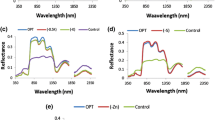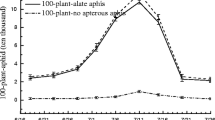Abstract
Field experiment was conducted during 2009–10 and 2010–11 rabi season at research farm of IARI, New Delhi for assessing the aphid infestation in mustard. In aphid infested plant the LAI was 67 to 94% lower than healthy plant. Chlorophyll concentration decreased to 50% in infested plant as compared to healthy plant. Infestation was more severe in late sown crop and due to aphid infestation the percentage oil content and yield was reduced significantly. The spectral reflectance of aphid infested canopy and healthy canopy taken in the laboratory had significant difference in NIR region. In the visible region, the reflectance peak occurred in healthy canopy at around 550–560 nm while this peak was lower by 31% in the aphid infested canopy. The reflectance for healthy crop was found to be more in visible as well as NIR region as compared to aphid infested canopy. The most significant spectral bands for the aphid infestation in mustard are in visible (550–560 nm) and near infrared regions (700–1250 nm and 1950–2450 nm). The different level of aphid infestation can be identified in 1950–2450 nm spectral regions. Spectral indices viz NDVI, RVI, AI and SIPI had significant correlation with aphid infestation. Hence these indices could be used for identifying aphid infestation in mustard.





Similar content being viewed by others
References
Anderson, T. W. (2004). An Introduction to multivariate statistical analysis. New Delhi: Wiley Eastern Pub.
Apan, A., Held, A., Phinn, S., & Markley, J. (2004). Detecting sugarcane ‘Orange Rust’ disease using EO-1 hyperion hyperspectral imagery. International Journal of Remote Sensing, 25, 489–498.
Asner, G. P. (1998). Biophysical and biochemical sources of variability in canopy reflectance. Remote Sensing of Environment, 64, 234–253.
Bhattacharya, B. K., Sastry, L. V. S., & Sastry, P. S. N. (2000). Prediction of oil accumulation and quality in oilseed Brassica on thermal time concept. Environment and Ecology, 18, 271–275.
Broge, N. H., & Mortensen, J. V. (2002). Deriving green crop area index and canopy hlorophyll dencity of winter wheat from spectral reflectance data. Remote Sensing of Environment, 81, 45–57.
Castro, A. M., Rumi, C. P., & Arriaga, H. O. (1988). Influencie of greenbug on root growth of resistant and susceptible barley genotypes. Environment and Experimental Botany, 28, 61–72.
Govender, M., Chetty, K., & Bulcock, H. (2007). A review of hyperspectral remote sensing and its application in vegetation and water resource studies. Water Science, 33, 145–152.
Hu, W. J., Huang, M. Y., Liu, L. Y., Wang Zhao, C. J., & Wang, J. D. (2004). Inversion of the severity of winter wheat yellow rust using proper hyper spectral index. Transact ions of the CSAE, 21(4), 97–103.
Jordan, C. J. (1969). Derivation of leaf-area index from quality of light on the forest floor. Ecology, 50, 663–666.
Kruse, F. A. (1998). Advances in Hyperspectral Remote Sensing for Geologic, Mapping and Exploration. Proc. 9 Australian Remote Sensing Conference, Sydney, Australia.
Malthus, T. M., & Madeira, A. C. (1993). High resolution spectroradiometry: spectral reflectance of field bean leaves infected by Botrytis fabae. Remote Sensing of Environment, 45, 107–116.
Mirik, M., Michels, J. R., Kassymzhanova, G. J., Mirik, S., Elliott, N. C., & Bowling, R. (2006). Spectral measurement of greenbug density and damage to wheat growing under field and greenhouse conditions. Journal of Ecology and Entomology, 99, 1682–1690.
Morgham, A. T., Richardson, P. E., Campbell, R. K., Burd, J. D., Eikenbary, R. D., & Sumner, L. C. (1994). Ultrastructural responses of resistant and susceptible wheat to infestation by greenbug biotype E (Homoptera: Aphididae). Annals Entomology Society, 87, 908–917.
Neog, P., Chakravarty, N. V. K., Srivastava, A. K., Gautom, B., Katiyar, R. K., & Singh, H. B. (2005). Thermal time and its relationship with seed yield and oil productivity in Brassica cultivars. Brassica, 7, 63–70.
Nino, E. I. (2002). The use of a multispectral radiometer to detect greenbug (Schizaphis graninum) damage in winter wheat, Triticum aestivum L. MS Thesis, West Texas A&M University, Canyon, TX.
Penuelas, J., Filella, I., Biel, C., Serrano, L., & Save, R. (1993). The reflectance at the 950–970 nm region as an indicator of plant water status. International Journal of Remote Sensing, 14, 1887–1905.
Penuelas, J., Baret, F., & Filella, I. (1995). Semi-empirical indices to assess carotenoids/chlorophyll a ratio from leaf spectral reflectance. Photosynthetica, 31, 221–230.
Pinter, P. J., Hatfield, J. L., Schepers, J. S., Barnes, E. M., Moran, M. S., Daughtry, C. S. T., & Upchurch, D. R. (2003). Remote sensing for crop management. Photogrammetry Remote Sensing, 69, 647–664.
Raikes, C., & Burpee, L. L. (1998). Use of multispectral radiometry for assessment of Rhizoctonia blight in creeping bentgrass. Phytopathology, 88, 446–449.
Richardson, A. D., Aikens, M., Berlyn, G. P., & Marshall, P. (2004). Drought stress and paper birch (Betula papyrifera) seedlings: effects of an organic biostimulant on plant health and stress tolerance, and detection of stress effects with instrument-based, noninvasive methods. Journal of Arboricultural, 30(52), 61.
Riedell, W. E., & Blackmer, T. M. (1999). Leaf refectance spectra of cereal aphid damaged wheat. Crop Science, 39, 1835–1840.
Rouse, J. W., Haas, R. H., Schell, J. A., & Deering, D. W. (1974). Monitoring vegetation systems in the Great Plains with ERTS. In: Proceedings, Third ERTS Symposium, NASA Sp-351, vol. 1, Washington, DC, pp. 309–317.
Saha, R. R., Ahmed, J. U., Rahman, S., & Golder, P. G. (2000). Yield and yield components of rapeseed and mustard as affected by debranching. Journal of Agricultural Science and Technology, 1, 97–102.
Schlerf, M., Atzberger, C., & Hill, J. (2005). Remote sensing of forest biophysical variables using hyper imaging spectrometer data. Remote Sensing of Environment, 95, 177–194.
Walthall, C., Dulaney, W., Anderson, M., Norman, J., Fang, H., & Liang, S. (2004). A comparision of empirical and neural network approaches for estimating corn and soybean leaf area index from landsat ETM + imagery. Remote Sensing of Environment, 92(4), 465–474.
Yang, Z., Rao, M. N., Elliott, N. C., Kindler, D., & Popham, T. W. (2005). Using ground based multispectral radiometry to detect stress in wheat caused by greenbug (Homoptera: Aphididae) infestation. Computers and Electronics in Agriculture, 47, 121–135.
Acknowledgement
Authors acknowledge Head, Division of Agricultural Physics, IARI, New Delhi for the facilities and PG school IARI for financial support to undertake study.
Author information
Authors and Affiliations
Corresponding author
About this article
Cite this article
Kumar, J., Vashisth, A., Sehgal, V.K. et al. Assessment of Aphid Infestation in Mustard by Hyperspectral Remote Sensing. J Indian Soc Remote Sens 41, 83–90 (2013). https://doi.org/10.1007/s12524-012-0207-6
Received:
Accepted:
Published:
Issue Date:
DOI: https://doi.org/10.1007/s12524-012-0207-6




